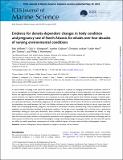Files in this item
Evidence for density-dependent changes in body condition and pregnancy rate of North Atlantic fin whales over four decades of varying environmental conditions
Item metadata
| dc.contributor.author | Williams, Robert | |
| dc.contributor.author | Vikingsson, Gisli A. | |
| dc.contributor.author | Gislason, Astthor | |
| dc.contributor.author | Lockyer, Christina | |
| dc.contributor.author | New, Leslie | |
| dc.contributor.author | Thomas, Len | |
| dc.contributor.author | Hammond, Philip Steven | |
| dc.date.accessioned | 2013-07-22T11:01:02Z | |
| dc.date.available | 2013-07-22T11:01:02Z | |
| dc.date.issued | 2013-03 | |
| dc.identifier | 60122356 | |
| dc.identifier | 5b527301-4221-4bc8-8a8c-269289614ffe | |
| dc.identifier | 84883254387 | |
| dc.identifier.citation | Williams , R , Vikingsson , G A , Gislason , A , Lockyer , C , New , L , Thomas , L & Hammond , P S 2013 , ' Evidence for density-dependent changes in body condition and pregnancy rate of North Atlantic fin whales over four decades of varying environmental conditions ' , ICES Journal of Marine Science . https://doi.org/10.1093/icesjms/fst059 | en |
| dc.identifier.issn | 1054-3139 | |
| dc.identifier.other | ORCID: /0000-0002-2381-8302/work/47531607 | |
| dc.identifier.other | ORCID: /0000-0002-7436-067X/work/29591693 | |
| dc.identifier.uri | https://hdl.handle.net/10023/3854 | |
| dc.description.abstract | A central theme in ecology is the search for pattern in the response of a species to changing environmental conditions. Natural resource management and endangered species conservation require an understanding of density-dependent and density-independent factors that regulate populations. Marine mammal populations are expected to express density dependence in the same way as terrestrial mammals, but logistical difficulties in data acquisition for many large whale species have hindered attempts to identify population-regulation mechanisms. We explored relationships between body condition (inferred from patterns in blubber thickness) and per capita prey abundance, and between pregnancy rate and body condition in North Atlantic fin whales as environmental conditions and population size varied between 1967 and 2010. Blubber thickness in both males and females declined at low per capita prey availability, and in breeding-age females, pregnancy rate declined at low blubber thickness, demonstrating a density-dependent response of pregnancy to prey limitation mediated through body condition. To the best of our knowledge, this is the first time a quantitative relationship among per capita prey abundance, body condition, and pregnancy rate has been documented for whales. As long-lived predators, marine mammals can act as indicators of the state of marine ecosystems. Improving our understanding of the relationships that link prey, body condition, and population parameters such as pregnancy rate and survival will become increasingly useful as these systems are affected by natural and anthropogenic change. Quantifying linkages among prey, fitness and vital rates will improve our ability to predict population consequences of subtle, sublethal impacts of ocean noise and other anthropogenic stressors. | |
| dc.format.extent | 2219139 | |
| dc.language.iso | eng | |
| dc.relation.ispartof | ICES Journal of Marine Science | en |
| dc.subject | Cetacean | en |
| dc.subject | Demography | en |
| dc.subject | Density dependence | en |
| dc.subject | Energetics | en |
| dc.subject | Fecundity | en |
| dc.subject | Marine mammal | en |
| dc.subject | QH301 Biology | en |
| dc.subject | SDG 14 - Life Below Water | en |
| dc.subject | SDG 15 - Life on Land | en |
| dc.subject.lcc | QH301 | en |
| dc.title | Evidence for density-dependent changes in body condition and pregnancy rate of North Atlantic fin whales over four decades of varying environmental conditions | en |
| dc.type | Journal article | en |
| dc.contributor.institution | University of St Andrews. School of Biology | en |
| dc.contributor.institution | University of St Andrews. Scottish Oceans Institute | en |
| dc.contributor.institution | University of St Andrews. Statistics | en |
| dc.contributor.institution | University of St Andrews. Marine Alliance for Science & Technology Scotland | en |
| dc.contributor.institution | University of St Andrews. Centre for Research into Ecological & Environmental Modelling | en |
| dc.contributor.institution | University of St Andrews. Sea Mammal Research Unit | en |
| dc.identifier.doi | https://doi.org/10.1093/icesjms/fst059 | |
| dc.description.status | Peer reviewed | en |
This item appears in the following Collection(s)
Items in the St Andrews Research Repository are protected by copyright, with all rights reserved, unless otherwise indicated.

